Origami is creative, origami is healing, origami is for anyone. Every single guest we invite to visit with us in ORIGAMIGOS has a very special gift, and that includes Dr. Lizzie Burns who generously shared every bit of what is special about her work with us. How lucky we were to have her talk to us about the health benefits that can be derived from using origami in a hospital setting.
This excerpt will give you a sense of Dr. Burns and her mission and we’d really like to share what a wonderful and inspiring interview this was that took place within the Origamigos Membership. It was pure joy, and I hope you enjoy it too.
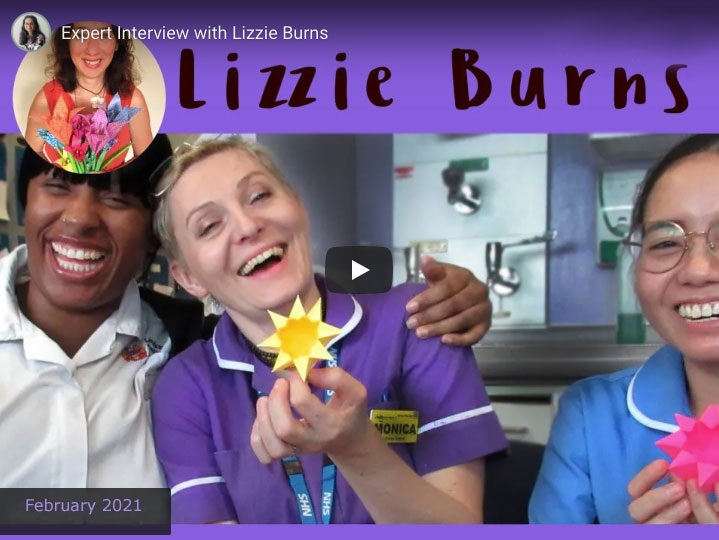
Lizzie Burns is the founder of the Anti-Boredom Campaign (ABC). Since 2011 Lizzie has conducted creative sessions that include the use of origami in the context of a hospital setting. Her introduction to origami was through one of her patients who wanted to teach Lizzie origami so that Lizzie could pass its benefits on to others.
VIDEO TRANSCRIPT
LEYLA TORRES: My official welcome to this session of the interview with an expert. Today, we are welcoming. Dr. Lizzie Burns. She is from the United Kingdom. She’s a science-based artist, creative specialist, and also a visiting academic in the department of physiology, anatomy and genetics at the University of Oxford. She is the founder of the Anti Boredom Campaign, ABC, that’s easy to remember. ABC. And she has conducted creative sessions that include the use of origami over the past 10 years, in the context of hospital settings. So, Lizzie was introduced to origami by one of her patients who wanted her to learn and pass it on. Welcome Lizzie today. Thank you for being here.
LIZZIE BURNS: Pleasure. Well many thanks, I’m really looking forward to sharing this with you. And I know we’ll make sure that we leave plenty of time for questions and for chatting, I think that would be really valuable. It’s already been amazing to me, Leyla, and to chat there. So I’m going to in a moment share some images as well. So if I go to share screen, and then I’ll introduce myself properly. Hopefully, here we go. See if this works.
So my name is Dr. Lizzie Burns, you’ll hear soon it actually comes from a science background. I describe myself as a science-based artist and a creative specialist. I do quite a few different things. And I’ll be sharing with you how I got into origami, how I got interested in boredom, and certainly how origami can help with that as well.
And I hope most of all to inspire you. For me, I think this picture at the start shows you everything that you need to know. It shows more. I think than any number or measurement could do. I think you can see the expressions and the joy. This was actually from November the previous year, working in a hospital with my lovely nurse colleagues, and I miss them greatly and working at the moment remote in this way. And I really hope they’re okay. All I can do is try and send my care through origami. But I think it’s about how it makes you feel I was saying to Leyla that’s the thing that I’m most interested in. So I hope these pictures will bring it to life for you.
So I ask the question. Why origami? I’m going to give you a little bit of an introduction to me. I suppose it’s a bit of an individual story, how I learned–– Leyla hinted at that as well––What I think that it brings––I think many things––the feedback that I’ve had because I’ve been encouraging feedback where I’ve been working with patients in hospital and from staff. It’s probably quite unusual actually to get that amount of feedback from people. A little bit about my work in hospitals and then sharing with you mostly wisdom from patients themselves from… that to me, the word straight from somebody’s mouth is often the most genuine and the most beautiful. And I’ll be sharing with you some of the work that we’re doing over this time called made with love. I saw the love is about protecting each other and how we’re using our economy to help.
This was a photograph with my colleague nurses, and it was just before… it would have been about this time last year actually. And we did a session wishing us peace and calm. We kind of knew that things would get difficult. So at a point when we could get that close to each other. So it was a special peaceful moment.
So my background, the doctor bit, I’m not a medical doctor. But I have a biology degree, and I did a doctorate and a postdoc at the University of Oxford in medical research, cancer research. So it’s quite close. And I am a cell biologist so I’m interested in the tiny, how things work. I’m just fascinated by life, and how beautiful it is and how intricate. And I found art a very good way of expressing that fascination and try to inspire and encourage others as well. So I call myself a science-based artist. I think it might be 19 years now I’ve been self-employed as a science-based artist. So, you probably haven’t met another.
This is part of a project it’s actually the same painting in the background. It is quite strange, but it’s one of my favorite. So people often look at it and go is it fruits, is it flowers…. But it’s it’s looking at a little tiny… peering down a microscope at blood cells. So something as disgusting maybe as blood is actually rather beautiful. Seeing these cells, red ones carrying oxygen, and the white ones which would fight infections looking out in this case for for some viruses hiding inside the cell and will go and attack and destroy.
And when you look down a microscope you’ve already changed it, you’re peering down microscope by keeping it still but I try to imagine within the body everything’s moving, its dynamic, and I’ve used brush strokes and a palette knife to try to bring it to life. I made little sculptures which I looked at. So, it’s just to show you my background, my fascination in science. And this case I interviewed scientists. I thought to me this captures everything. Biology makes me appreciate the beauty and complexity of life and I never cease to be amazed. Just to whet your appetite I really do think origami is clearly science and art together. And it also reflects actually what’s inside our own body as well. So, I hope it whets your appetite a little bit.
So I’ve also been doing a lot about the brain. I’m fascinated by the brain. This is the organ in our body that makes us who we are, where we experience everything. We’re never really out here. It’s all experienced in here. So I guess I’m also fascinated by the mind, and I worked in this case very closely with an amazing neuroanatomist. He was in his late 80s. He was writing his last book, and it’s about his lifetime’s knowledge about the brain, and neuroanatomy. And I learned an awful lot drawing. I have to say I think that the origami helps me. I was practicing origami at the time, all about precision and structure, actually, and discipline, to sort of really be strict. And, so I think I did learn an awful lot actually, for the origami, it may not be quite so apparent but that attention to detail, persistence again, these sort of positive attitudes.
Again a little bit of my background. I would encourage children to get creative. To learn about science and create and discover and out of everybody I think children are the best to gain experience of communicating with others because… they’re so… they’re not trying to cover how they feel. it’s fairly obvious from their faces how they’re feeling. Which I love.
I love this quote. “Today is great. You can Unleash Your wild imagination.” I have to say I feel like a kid. Because I will get really excited about things. So I learned an awful lot about how to inspire creativity from children. And adults are the tough ones I have to say because we all judge ourselves way too much. I’m not creative. I can’t do this. And we stopped ourselves been creative. Really. There’s no right or wrong when it comes to art. And so I started to do some in my work some work with adults, and I just loved seeing this liberation that creativity can bring I mean you can again see that sense of joy, how it makes people feel. Thanks for the rare opportunity as an adult to play. I’ve completely forgotten how much I enjoyed messing around with paints. And you can just see the lovely connection with them, and the idea that creativity can be developed.
Can you see what they’re painting there as well? It’s a virus! (laughs) They always unleash creativity that’s subject. Strangely. So, actually working with adults is what got me to work in a hospital with adults, and to encourage them to be creative, so it does… one thing leads to another as things do in life. It’s a journey. So I work one day a week in a hospital in London, University College Hospital is supported by their Hospital charity. I finally came up with the name that describes me. I’m not an art therapist. Art therapy is its own discipline and it comes from psychotherapy, and it comes from psychiatry. I found very quickly that people actually didn’t want to anything to do with illness, and I think that’s quite significant. So, that is not my background. I work as a as a self-taught artist. So I called myself a creative specialist, one day a week, and I’d visit adults who are being treated for cancer. And I’d encourage them to get creative in support of staff and patient well-being. It’s very important. I would encourage people to try something new to spark their imagination ideally to continue themselves as well.
And I guess as a scientist, I’m fascinated by what value does this have? Is there anything that you can measure? You know is it worthwhile alongside medicine that you can quite clearly measure whether it’s having an effect. But you know what I’ve learned more than anything… it’s the expression. Look at those faces. What a lovely moment they’re having together. And actually, so many of the patients that I’ve worked with would have cancers which actually the survival rate wasn’t that great. So, you just learn to encourage people to grab the moment. Enjoy what you can do now, and that will… that’s really precious time. None of us should be just putting aside… ‘Let’s do it another time, I’m busy now. I’m waiting.’ Those are people are busy waiting waiting for what? Come on and try something new.
So it was through that work that I kind of, yeah, I ended up doing origami… and first of all I encouraged people to draw and paint… [it was] pretty hard. If you can get someone to do it, they’ll have a great time. But most people, because of that prejudgment will think that they can’t, can’t do anything. So I ended up doing things more like doodling. Doodling is brilliant. Encouraging people not to have a plan, see what happens. And I think actually… it’s is just amazing, I’ve created giant doodles where people did a little doodle on a tiny piece of paper and then putting them into giant doodles and collages and we’d look at them and find patterns and similarities with each other. People could be abstract, or they might be representative… and I think actually, funnily enough, I think doodling and origami are exactly what we used to do at school, when we’re a bit trapped and we’re maybe not enjoying a lesson, it’s not really where we want to be.
These are little gentle ways that we’ve rebelled and had fun with our friends. And I think come with a lot of warm positive feelings. Whereas art, I think is often been quite judged by their teacher. Usually that they’re not good, is how most people would feel. I would also bring in lots of little boxes of natural things. So, I’d bring in fossils, a little bit of a dinosaur bone, or a bit of a meteorite. That’s just brilliant. Strikes up all sorts of conversation. But probably more than anything. If you can make something yourself, the sense of achievement is wonderful.
So goodness, I’m trying to focus more on the origami but the origami has grown so beautifully. So it started for me back in 2011. So, it’s not that long ago is it? Leyla said it’s 10 years ago. And I visited one patient, encouraged her, had little bags then so this was what she did, she drew a little bags and I’ll keep things in there. But she’s like, I’m not actually that keen on drawing, so next time I want you to visit and I’m going to teach you something, and I want you to learn, and I want you to pass it on because it’s something that’s helped me as a child, and as an adult, and I think it will help others.
Now, I didn’t know what it was, that it was going to be origami, and I have to say I suppose in a weird way I prejudged myself God that’s not something I can do. That’s not something that I could do, would want to do, but because it was a patient asking you to learn and pass it on of course I had to, and in the best possible way. So, she’s actually grown up in Hong Kong, and she had been unwell as a child and learnt hospital to make traditional lilies, the origami flowers. And being unwell again as an adult. And she taught me how to make the lilies I got a bunch here actually… this Bunch will be 10 years old now but it still looks so lovely, doesn’t it? It’s still so nice.
I have to say, I remember my head really hurting learning this because it was so outside of my comfort zone. I generally, as an artist, make stuff up. I go with my own flow. I have no plan. This is all very planned and very structured. But I soon found that… my head hurt at first, the satisfaction of learning something that maybe was pushing around boundaries was really good. And that’s when people say, oh, you know, that’s not what I want to do… that’s exactly why you should give it a go.
So I suppose the slightly less traditional that she would make would show me how to roll the stems with glue and then cut off the bottom of the flower and put them in. And she would wrap them up in tissue paper, maybe spray them with perfume as well and she said she would give them to health care, you know, doctors and nurses who cared for her. And she would make this in hospital and found that it would really help her, but it would also make others smile. It’s really special if somebody gives you something that they’ve made. So she was like you can make bunches of flowers.
You you will become evangelical for it because you it’s not something that you naturally do. It’s good to challenge yourself. And I found out of everything, there’s something about it, it’s almost like you’re charged it really lifts your mood. It just brings an energy. Yeah. There’s this… Leyla maybe you could share that link sometime if you want. It’s a nice little film of… it’s a wider film about the the hospital charity, and about boredom and about origami and how it helps. And here with a patient.
And actually the person who is filming was saying, oh this is really good origami, this is like releasing your tension before filming. Everybody gets really nervous. And I think the origami is helping us. So again, you can see the bunches of flowers… with my bunches of flowers in the hospital. But it’s that complete focus that it brings. So in terms of well-being, it’s I think your well-being is quite hard thing to define and we’re hearing a lot about it and I think we’re getting very aware of the importance of looking after your well-being. Now I got this sort of list from a book about natural law. So, it’s kind of it’s a bit bizarre, it’s about law, and it’s about philosophy. And it was recommended to me by a psychiatrist actually. He was like, I think you’d find that interesting. And there was one section about well-being and John Ennis had come up with a sort of list of seven ingredients for well-being which I found really interesting and I thought it fitted origami really quite well.
So the first was for your basis for well-being as life, basically your health, right? There’s only so much you can do about that. So if you’re unwell, that’s not something where we can do other than being in a hospital looked after. That bit, we can’t help with.
Second, knowledge. And actually basically for its own sake. As human beings we love learning, just learning things just out of our own interest.
Third thing which is almost quite surprising to include on the list for adults, but I think it’s really important, is play. That need to engage. And we probably… we play within conversation, within so much that we do but obviously, as adults, we tend not to use the word play but being playful I think is very important.
Fourthly aesthetic experience as being important towards well-being. Beauty. Beauty is really important. And in some ways actually traditionally in art isn’t actually seen that positively. It almost seems as a bit naive that something would be beautiful. Yeah. There’s one one interesting idea is that we are attracted to maybe the opposite of what’s going on in our lives, so it could be… actually if we’ve got a reasonably good life then maybe we do want to see you no more disruptive or more traumatic images. Whereas actually if things are pretty awful, maybe you want a bit of beauty. So I started to see the value, maybe, in things like a beautiful flower when life actually isn’t that great is quite powerful. So we enjoy Beauty.
Fifth ingredient for well-being sociability, friendship, that interaction with others.
Sixth is practical reasonableness which he explained as the ability to choose how to make a situation better. So, origami again gives you a little bit of choice of a tool that you can use. And obviously previously in sociability, obviously origami brings that, it’s very much transmitted from one to another.
Finally religion, but in kind of loose quotations, more of a general that things might make some kind of sense so order of the cosmos and actually I think that origami does really tie in with science, which, I mean for me–– I’m an atheist-–is gives me some kind of understanding that things do make some kind of sense. Sort of. So… is it getting a bit dark Leyla? Did you want me to put the light on? Am I getting a bit dark at this end?
LEYLA TORRES: This is fine. I can see you perfectly and your voice is lovely… we…. your enthusiasm shines through.
LIZZIE BURNS: Thank you Leyla. Thank you very much. So this is my kind of list of… this is just my own thoughts honestly.
What does our origami bring? Out of everything I have to say that I offered, it was always the origami that caught people’s imagination and attention. It has very wide appeal. So, very wide appeal I think is really powerful. It brings a sense of beauty, and wonder, which… yeah, which captivates people of all backgrounds, both men and women as well. And across class too.
That I think also quite significantly origami brings order. And I think that’s particularly significant because our lives… when our lives feel out of our control that’s illness and I have to say at the moment all our lives are out of our control. It’s not good for our well-being. So origami allows you to form something that’s very orderly and structured. Very controlled. Encourages that self-discipline and that focus. But I think that’s really healthy for the mind actually otherwise things are out of your control.
Origami at heart is very simple, but it’s also very complex. It’s both those things. I find that something that’s really interesting. Also brings learning. I don’t know about you, but trying to try to learn and memorize things it requires a lot of mental agility and focus. Memory. The spatial side I think is particularly significant. And I found it really interesting in this process of the ten years, you know my head hurting at first. And then with time now, I just find it fascinating. I can sit there thinking about how I’d fold something. And it’s a kind of… I can visualize it whereas I didn’t use to be able to do that. So, clearly my brain has changed through that memorizing and being more aware of the spatial side.
Origami brings connection with others. It’s all about sharing an interaction. Nobody would be doing origami if people hadn’t passed it on. It’s all about community. And for so many people actually, in the hospital, I’d find that it would bring back happy memories from time with grandparents, with friends. It’s about the interaction. Every time I find it elevates mood and because it’s quite hard, it brings a huge sense of achievement. I try and encourage people to stick with it. We’ll have fun, we’ll will be playful, we will get there I will make sure of it. And you need that really positive experience to get you started. I think for me, personally, I’d looked at books and I felt like I couldn’t do it. I couldn’t follow diagrams. So I think you often need a person to get you started, who’s patient and kind. It’s very self-motivating, once you get started. I’m sure you’re the same you just can’t stop in the loveliest way. Hence, it really helps with boredom because then maybe you don’t know what to do. But you do. With origami, there’s always something that you want to do.
It encourages you to take time out. To be patient. To be respectful I think to the paper. But that’s also to yourself as well. You’re having to be careful. Your having to be thoughtful and again, I think that you’re nurturing inside yourself as well. I think that the models that people fold in every way has meaning. It may be abstract as you’ll see maybe bit later. I find a lot of meaning in the abstract as well. But obviously more flowers and animals people can obviously find meaning. But I think people always find meaning and things. That’s what art is actually it’s meaning-making really. Most of all it’s wonderful because it’s the cheapest most available material and its basis of so much of our civilization, isn’t it? Paper. It’s an everyday material. Even if it’s the junk that’s been pushed through your door, you can make it into something special. You transform it. And I think it’s almost like mood. You start off a bit flat. You don’t know what to do. And you transform it to something amazing. Just going to grab a cup. Now for tea, I think. So that’s some of the things all of that from paper? Isn’t that unbelievable?
And I’m going to share just some of the feedback that I’ve had some patients. It’s more just to give you a feel for… it’s not just one person it’s lots of people. So this is over 500 people have given feedback.
Was a session doing some origami together helpful? 99% Yes, that’s amazing. And I asked people how? Now I didn’t do a little tick box which would have been easier for me. I just let people write down whatever they wanted. And then try to then loosely classify their answers. About half is the mental stimulation. Other areas, about connecting to others, not feeling alone we’re all hearing lots about loneliness. And it lifts your mood. And these can be… these are people in really difficult circumstances. Then sometimes just before dying, really. How does it make you feel? Happy! Happy, we know that but it sounds such a fussy answer and it’s so important isn’t it? How you feel is everything. It makes you feel happy and relaxed. Sense of achievement. Do you want this to continue? Everyone who wrote the answers are yes.
Related Posts:
- How a Paper Heart can Help You Stay Healthy
- Origami Art Therapy for Mental Health
- Recovering Health Through Origami
- The Smile of Mona Lisa
- Dr. Lizzie Burns Uses Origami in her Anti-Boredom Campaign
- Origami – A Help to Alzheimer’s Patients
- Stay Calm and Make an Origami Ladybug
- All That’s Worth Cherishing Begins in the Heart

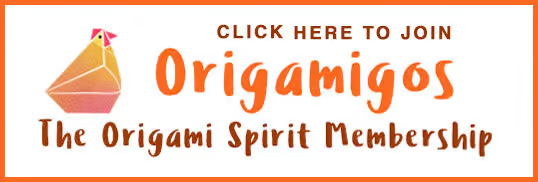
Maravilhoso trabalho. É importante que origami, seja divulgado como uma arte curativa e que atende a todas faixas etárias. Parabéns, a ambas, pela divulgação desta arte.